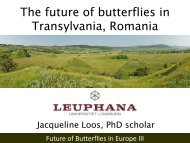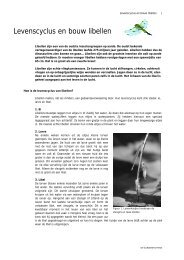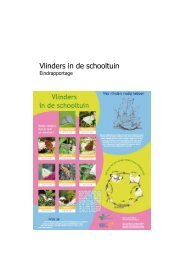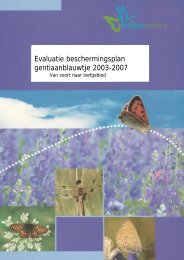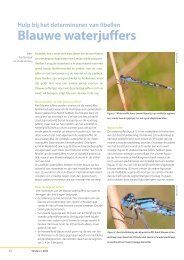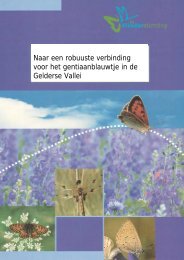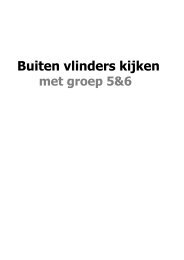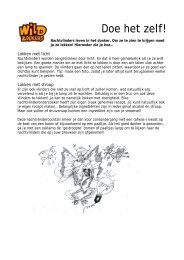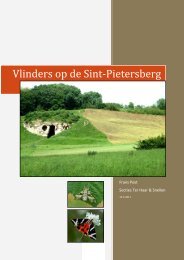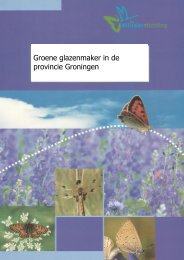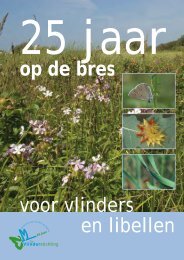Final Report October 2011 for the BBI-Matra/2008/015 ... - Vlindernet
Final Report October 2011 for the BBI-Matra/2008/015 ... - Vlindernet
Final Report October 2011 for the BBI-Matra/2008/015 ... - Vlindernet
You also want an ePaper? Increase the reach of your titles
YUMPU automatically turns print PDFs into web optimized ePapers that Google loves.
Monitoring: false apollo (Archon apollinus)<br />
transects: A 150 m transect was established and<br />
monitored on seven occasions between April<br />
2009 and May <strong>2011</strong>.<br />
Regular recording: Visits made approximately<br />
twice a month throughout <strong>the</strong> butterfly season.<br />
False apollo (Archon apollinus)<br />
Data from <strong>the</strong>se and o<strong>the</strong>r field visits were added to <strong>the</strong> data set <strong>for</strong> <strong>the</strong> PBA analysis.<br />
Problems encountered<br />
None.<br />
Activity outputs and additional benefits<br />
Potential PBAs<br />
Fieldwork has shown that mining is a threat at several locations, including Kopdağı PBA. A gold mine has destroyed<br />
<strong>the</strong> type locality <strong>for</strong> <strong>the</strong> endemic Turkish false argus (Aricis torulensis) at Demirkaynak. As a direct result of <strong>the</strong><br />
in<strong>for</strong>mation collected on this visit this species was listed as Endangered during <strong>the</strong> red list assessments.<br />
Gaps in <strong>the</strong> data<br />
Amasya area: Four areas around <strong>the</strong> city were visited and in<strong>for</strong>mation was collected on habitats and threats.<br />
Küre Mountains: Part of <strong>the</strong> area is a national park. A report on <strong>the</strong> fieldwork (which included birds and<br />
butterflies) was submitted to <strong>the</strong> Directorate in September 2010. See 06.6.2 group in annexes<br />
Steppe: Data from this and o<strong>the</strong>r field visits were added to <strong>the</strong> data set. See 01.1_TurkeyButterflyData_ALL.xls in<br />
<strong>the</strong> annexes<br />
Threatened species<br />
Mesopotamian blue (Polyommatus dama); Endangered; Butterflies were found in good numbers in five 10x10 km<br />
squares, four of <strong>the</strong>m new localities. The second team, led by Evrim Karaçetin, collected baseline data on<br />
population size toge<strong>the</strong>r with in<strong>for</strong>mation on <strong>the</strong> butterfly’s habitat and behaviour.<br />
Two reports on <strong>the</strong> Mesopotamian Blue surveys were prepared by <strong>the</strong> participants See 06.3 and 06.6.3 annexes<br />
Following publication of <strong>the</strong> Red Book, butterfly watchers were encouraged to collect new in<strong>for</strong>mation on<br />
threatened species and project money was offered to cover <strong>the</strong>ir travel costs as an incentive. Two people chose<br />
species and collected new data be<strong>for</strong>e <strong>the</strong> end of June <strong>2011</strong>.<br />
Ottoman’s Copper (Lycaena ottomana); Near Threatened; Ümit Basaran, a butterfly watcher from Edirne (Thrace),<br />
provided a report, including records from 2010 and <strong>2011</strong> with detailed location in<strong>for</strong>mation and photographs of <strong>the</strong><br />
butterfly and its habitat. See annexes <strong>for</strong> Ottoman’s Copper report, in Turkish – 06.6.3 annex<br />
Steely argus (Aricia bassoni) Data Deficient (last recorded 1976)<br />
Bolland’s Blue (Polyommatus bollandi) Critically Endangered (last recorded 1998) Following his involvement in <strong>the</strong>se<br />
species assessments <strong>for</strong> two little known species in Hatay, local butterfly watcher, Ali Atahan, obtained permission<br />
from <strong>the</strong> Jandarma to visit <strong>the</strong> areas where <strong>the</strong>y had been recorded (both were in sensitive border areas, close to<br />
Syria) and made visits in May <strong>2011</strong>. Both species were refound and photographed, and data was collected on <strong>the</strong>ir<br />
habitats.<br />
An article about <strong>the</strong> rediscoveries was published in National Geographic-Turkey in July <strong>2011</strong>, on <strong>the</strong> page opposite<br />
DKM’s PBA and threatened species poster.<br />
Article from National Geographic-Turkey, July <strong>2011</strong>, on <strong>the</strong> rediscovery of two rare butterflies, with Ali Atahan’s<br />
photos. See annex 03.3 <strong>for</strong> a pdf of <strong>the</strong> full article<br />
Selected PBA<br />
Research into <strong>the</strong> biology of steppe fritillary (Euphydryas orientalis):<br />
An article about <strong>the</strong> conservation status of <strong>the</strong> steppe fritillary and <strong>the</strong> research carried out during <strong>the</strong> project<br />
was published in Bilim ve Teknik magazine in May <strong>2011</strong>. A pdf of <strong>the</strong> published article and <strong>the</strong> English text can be<br />
found in <strong>the</strong> annexes 05.2. and 06.6.3<br />
Following <strong>the</strong> discovery of <strong>the</strong> foodplant, subsequent searches <strong>for</strong> eggs or ‘nests’ of young caterpillars have<br />
been unsuccessful and raise questions about <strong>the</strong> species’ breeding cycle which have yet to be answered.<br />
DE VLINDERSTICHTING & BCE <strong>2011</strong> | Butterfly Conservation in Turkey – <strong>Final</strong> report <strong>2011</strong> 48





